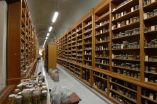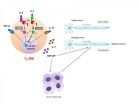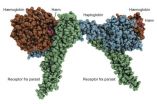(Press-News.org) Are Italian natural history museums (NHMs) on the verge of collapse? A new analysis published in the open access journal ZooKeys points out that these institutions are facing a critical situation due to progressive loss of scientific relevance, decreasing economic investments and scarcity of personnel.
The study proposes that existing museums associate and collaborate to form a diffused structure, able to better manage their scientific collections and share resources and personnel.
"Italy is universally known for its history, culture, food and art. The list of Italian cultural assets could go on for pages, but in our study we want to focus the attention on another invaluable and often forgotten asset: natural history museums (NHMs) and the scientific specimens they preserve to document national (and planetary) biodiversity.", explains the lead author Dr. Franco Andreone, a zoologist from the Museo Regionale di Scienze Naturali in Turin, Italy.
The team of 30 Italian authors outlines a number of problems faced by NHMs in the country to reveal an alarming situation, especially for ensuring the long-term preservation of the precious collections hosted.
Unlike in other countries (e.g., England, France, Spain, and USA) where there is a national museum acting as the main repository for large part of historical and contemporary natural history collections, Italy has never developed a centralized structure for the preservation of its collections.
The lack of a centralized national institution results in collections scattered among several museums, most of which with objective difficulties in managing their materials and recognise their scientific value. This situation raises concern about the impending demise of important collections.
For example, the number of unique animal and plant specimens housed in Italian museums is considerable, with at least 150 mammal taxa having their original types preserved there, while the types of insects are almost countless. The conservation of these specimens, however, requires serious scientific effort. Most of these exemplars are also still uncatalogued, and this task cannot be done without ensuring persistence and regular turnover of the curatorial personnel.
Another problem posed by personnel scarcity is caused by the fact that basic technical tasks for daily management and educational activities have necessarily become priorities in many museums, forcing curators to redirect their activities, and to reduce or cease their research work and assistance to scientists.
Moreover, a commitment in fieldwork to increase scientific collections and concurrent taxonomic research are rarely considered priorities by institutions in the country, while most of the activities are addressed to public events with evident political payoffs, such as exhibits, didactic meetings, expositions and talks.
To face these problems authors propose most of the NHMs in Italy to join forces and form the so called sort of a "meta-museum". This innovative concept requires the existing museums to establish a reciprocal interaction network, with shared budgetary and technical resources that will assure better coordination of common long-term goals.
"How this can be achieved is mostly a political matter, but cannot be postponed any longer and must urgently be integrated into the political agenda of the Italian government. For now, we hope that both, the Italian Ministry for Education, University and Research and the Italian Ministry for the Cultural Heritage and Activities and the Tourism, will soon pay the overdue attention to our NHMs and consequently adopt suitable policies to safeguard their collections.", argue Dr. Andreone and colleagues from the major NHMs and universities in Italy.
INFORMATION:
Original Source:
Andreone F, Bartolozzi L, Boano G, Boero F, Bologna M, Bon M, Bressi N, Capula M, Casale A, Casiraghi M, Chiozzi G, Delfino M, Doria G, Durante A, Ferrari M, Gippoliti S, Lanzinger M, Latella L, Maio N, Marangoni C, Mazzotti S, Minelli A, Muscio G, Nicolosi P, Pievani T, Razzetti E, Sabella G, Valle M, Vomero V, Zilli A (2014) Italian natural history museums on the verge of collapse? ZooKeys 456: 139-146. doi: 10.3897/zookeys.456.8862
Scientists from Uppsala University, the Science for Life Laboratory (SciLifeLab) in Stockholm and Uppsala University Hospital have developed a new method of rapidly identifying which bacteria are causing an infection and determining whether they are resistant or sensitive to antibiotics. The findings are now being published in the Journal of Clinical Microbiology.
'Clinical use of the method would mean that the right antibiotic treatment could be started straightaway, reducing unnecessary use of antibiotics,' says Professor Dan I. Andersson of Uppsala University, who ...
HOUSTON - (Nov. 24, 2014) - New computer models that show how microtubules age are the first to match experimental results and help explain the dynamic processes behind an essential component of every living cell, according to Rice University scientists.
The results could help scientists fine-tune medications that manipulate microtubules to treat cancer and other diseases. Rice theoretical biophysicist Anatoly Kolomeisky and postdoctoral researcher Xin Li reported their results in the Journal of Physical Chemistry B.
Microtubules are cylinders made of 13 protein strands ...
People with moderate to severe obstructive sleep apnea may have an intrinsic inability to burn high amounts of oxygen during strenuous aerobic exercise, according to a new study led by researchers at University of California, San Diego School of Medicine.
The study, reported in the current issue of Journal of Clinical Sleep Medicine, shows that people with sleep apnea, in which breathing repeatedly starts and stops during slumber, have a lower peak oxygen uptake during aerobic activity than those who do not suffer from the sleep disorder.
People who suffer from apnea ...
From coral reefs to prairie grasslands, some of the world's most iconic habitats are susceptible to sudden collapse due to seemingly minor events. A classic example: the decimation of kelp forests when a decline of otter predation unleashes urchin population explosions. Three studies published in the Nov. 24 special issue of Philosophical Transactions of the Royal Society Biological Science hold the promise of helping resource managers predict, avoid, and reverse the tipping points that lead to degraded habitats, economic losses, and social upheaval.
The studies are the ...
Good communication between brain cells is vital for optimal (mental) health. Mutations in the TBC1D24 gene inhibit this process, thereby causing neurodegeneration and epilepsy. Fruit flies with a defect in Skywalker, the fruit fly variant of TBC1D24, are being used as a model for neurodegeneration. Researchers from VIB and KU Leuven have succeeded in completely suppressing neurodegeneration in such fruit flies, by partially inhibiting the breakdown of 'defective' proteins in brain cells.
Patrik Verstreken (VIB/KU Leuven): "These unexpected results offer us a new line ...
VIDEO:
High-dose interleukin-2 can be effective in selected metastatic renal cell cancer patients pre-treated with VEGF-targeted agents, reveals research presented today at the ESMO Symposium on Immuno-Oncology in Geneva, Switzerland....
Click here for more information.
Lugano/Geneva, Switzerland, 24 November 2014 - High-dose interleukin-2 can be effective in selected metastatic renal cell cancer patients pre-treated with VEGF-targeted agents, reveals research presented ...
A multi-disciplinary research team from the National University of Singapore (NUS) has made a breakthrough discovery of a new type of immune cells that may help in the development of a future treatment for multiple sclerosis (MS).
Led by Professor Xin-Yuan Fu, Senior Principal Investigator from CSI Singapore and Professor at the Department of Biochemistry at the NUS Yong Loo Lin School of Medicine, and Dr Wanqiang Sheng, post-doctoral fellow at CSI Singapore, the team found that a new type of immune T helper cells named TH-GM cells play a crucial role in the immune system ...
(MEMPHIS, Tenn. - November 24, 2014) Most long-term survivors of retinoblastoma, particularly those who had been diagnosed with tumors by their first birthdays, have normal cognitive function as adults, according to a St. Jude Children's Research Hospital study. The research, which appears in the current issue of the journal Cancer, found that the vast majority of survivors work full time, live independently and fulfill other milestones of adult life.
The study is the first to examine how adult survivors of retinoblastoma fare cognitively and socially decades after their ...
Researchers from Aarhus University have taken an important step in the fight against sleeping sickness, a disease that is a major problem in parts of Africa. According to the World Health Organization (WHO), the disease threatens approximately 60 million people and the treatment options are poor.
The deadly disease is caused by a parasite that is transferred to people via the bite of the African tsetse fly. The parasite lives in the bloodstream where it absorbs haemoglobin from human red blood cells. However, if left untreated it can infect the central nervous system ...
(Boston)--Changing the way doctors practice medicine is difficult, however a new study has shown that combining traditional education with quality improvement and incentives improves Human Papilloma virus (HPV) vaccination rates in boys and girls. The study, which appears on-line in the journal Vaccine, has the potential to produce sustained improvements in these vaccination rates.
Every year, approximately three million Americans seek treatment for HPV related diseases. Twenty-seven thousand Americans develop HPV-related cancer while more than 5,000 people die from this ...





